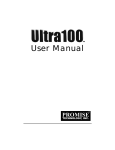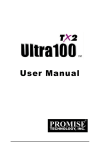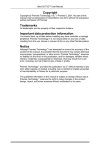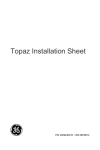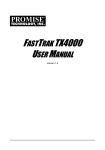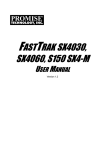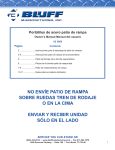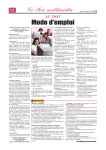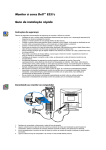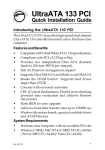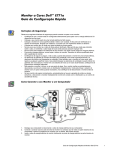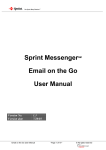Download User`s Manual - Promise Technology, Inc.
Transcript
Ultra66 User’s Manual Version 1.0 Ultra66 Copyright Copyright by Promise Technology, Inc. (“Promise”), 1999. No part of this manual may be reproduced or transmitted in any form without the expressed written permission of Promise. Promise is not liable for any errors contained herein, or incidental or consequential damages in connection with furnishing this material. The published information in the manual is subject to change without notice. Promise reserves the right to make changes in the product design, layout, and driver revisions without notification to its users. Trademarks All trademarks are the property of their respective holders. Important Data Protection Information Back up all data before installing Ultra66. Promise is not responsible for any loss of data resulting from the use of this or any other Promise product. PROMISE TECHNOLOGY, INC. i Table of Contents Introduction . . . . . . . . . . Features . . . . . . . . . . Section 1 - Getting Started Unpacking Ultra66 . . . . . . . . . . . . . . . . . . . . . . . . . . . . . . . . . . . . . . . . . . . . . . . . . . . . . . . . . . . . . . . . . . . . . . . . . . . .1 .1 .2 .2 Section 2 - Hardware Installation . . . . . . . . . . . . . . .4 Controller Card Installation . . . . . . . . . . . . . . . .4 Hard Drive Installation . . . . . . . . . . . . . . . . . . .4 Section 3 - Software Installation . . . . . . . . . . . . . . .6 DOS . . . . . . . . . . . . . . . . . . . . . . . . . . . . . . .6 Windows 9X . . . . . . . . . . . . . . . . . . . . . . . . . .6 Windows NT . . . . . . . . . . . . . . . . . . . . . . . . .11 Section 4 - BIOS Upgrade . . . . . . . . . . . . . . . . . . .14 Appendix A - Troubleshooting . . . . . . . . . . . . . . . .15 Appendix B - Contacting Technical Support . . . . . .17 Technical Support Services . . . . . . . . . . . . . . . .17 Appendix C - Limited Warranty . . . . . . . . . . . . . . .18 Disclaimer of Other Warranties . . . . . . . . . . . . .18 Appendix D - Returning Product for Repair . . . . . . .20 Your Responsibilities . . . . . . . . . . . . . . . . . . . .21 ii PROMISE TECHNOLOGY, INC. Introduction Introduction Thank you for purchasing Promise Technology’s Ultra66. The Ultra66 controller card provides two IDE hard drive connectors that support Ultra ATA/66 protocols, perfect for such demanding applications as real-time video, multimedia, and highperformance operating systems. Ultra66 installs easily into any available 32-bit PCI slot on your system’s motherboard. Ultra66’s two IDE connectors each support a master/slave combination of any IDE devices, including IDE, EIDE, Fast-ATA, and Ultra-ATA standards. Devices of different standards can be connected to Ultra66 without performance degradation, due to the independent programmable timing registers in the controller’s design. Features Performance • • • • • • • Sustained transfer rates up to 66MB/sec Up to 133MB/sec burst transfer rates (through PCI bus) CRC checking with Ultra ATA hard drives Dual independent channel PCI IDE bus master controller PCI “Plug & Play” compatibility Coexists with IDE and SCSI controllers Onboard BIOS with LBA translation and Extended Int 13, supporting IDE hard drives up to 128GB • Flashable BIOS allows easy upgrades Physical/Environmental Dimensions • 4.75" x 3" (12.07cm x 7.62cm) Operating Temperature • 32ºF to 122ºF (0ºC to 50ºC) Relative Humidity • 5% to 95% (non-condensing) Warranty • Two years limited parts and labor PROMISE TECHNOLOGY, INC. 1 Section 1 Getting Started This section is designed to help you prepare Ultra66 for installation into your system. Please read through this chapter carefully before attempting to install Ultra66. You should record the system’s current CMOS (system setup) settings before making any changes. Unpacking Ultra66 The Ultra66 package should contain the following items: • 1 Ultra66 controller card • 1 Ultra66 User’s Manual • 1 diskette (“Ultra66 Drivers”)* • 1 80-wire, 40-pin IDE cable • 1 Registration card If any of the contents are missing or damaged, please contact your dealer or distributor immediately. ! Ultra66, like every other valuable part of your system, is subject to static electricity. Be sure that you’re properly grounded (Promise recommends that you wear an antistatic strap, or touch a grounded object), and that your system is unplugged before installing Ultra66. * Includes the following files: root directory - README.TXT; DISK1; TXTSETUP.OEM; ULTRA66.SYS; ULTRA66.MPD; ULTRA66.INF;ADVPACK.DLL; PTISTP.DLL; PU66VSD.DLL; NT 3.51 directory - OEMSETUP.INF; TXTSETUP.OEM. 2 PROMISE TECHNOLOGY, INC. Section 1 IDE connectors IDE1 IDE2 PROMISE LED connector (J1) TECHNOLOGY, INC. Figure 1-1: Ultra66 controller card Figure 1-2: Typical Ultra66 controller card installation PROMISE TECHNOLOGY, INC. 3 Section 2 Hardware Installation Installing the Ultra66 controller card in a system is a simple process. The card fits into any available 32-bit PCI slot on the system’s motherboard (see Figure 1-2). Controller Card Installation 1 Remove the cover of your system. 2 Remove the inside slot cover of an available 32-bit PCI slot on the motherboard. 3 Install the Ultra66 controller card into the open slot (see Figure 1-2). 4 Attach your system case’s 2- or 4-pin LED cable to the LED connector on the Ultra66 controller card (see Figure 1-1). Make sure that pin 1 on the connector is aligned with pin 1 of the cable. 5 Fasten the controller card bracket to the system case (see Figure 1-2). Hard Drive Installation If you’re installing Ultra66 into a system with an existing Windows NT operating system, do not connect any hard drives to the Ultra66 controller before installing the driver software. Drives attached to the Ultra66 controller card cannot boot Windows NT without driver support. 1 Configure the jumpers of the hard drives you’re preparing to install with Ultra66 with the proper master/slave settings. You may need to refer to your hard drive’s manual for more information. 2 Install the hard drives in the proper hard drive bays of your system. 3 Attach the IDE cable to the hard drives and to the IDE connectors on the Ultra66 controller card (unless you’re installing Ultra66 on a system with Windows NT already installed; see “Hard Drive Installation,” above, for more information). The colored edge of the cable(s) indicates pin 1 (see Figure 1.1), and the blue cable connector must be attached to the Ultra66 connector. 4 If two drives are connected via the same cable, make 4 PROMISE TECHNOLOGY, INC. Section 2 sure that one drive is configured as a master drive, the other as a slave. ! You must use 80-wire, 40-pin cables when connecting Ultra ATA/66 hard drives to the Ultra66 controller card. The Ultra66 package contains one 80-wire, 40-pin cable. If you’re connecting two Ultra ATA/66 hard drives to the Ultra66 controller card, purchase an additional 80-wire, 40-pin cable. PROMISE TECHNOLOGY, INC. 5 Section 3 Software Installation This section details the Ultra66 driver installation procedure when used with various operating systems. DOS For first-time installation, follow the standard procedure of installing DOS onto your hard disk (partition all hard drives with FDISK and format before performing the following procedure): 1 Insert “Disk 1” of your DOS installation diskettes into drive A:. 2 Type “A:SETUP” at the “A:\” prompt. 3 Continue with normal DOS installation procedure, and refer to your DOS manual for additional details. i The Ultra66 BIOS supports both DOS and Windows 3.1x without software drivers. Windows 95/98 Installing Drivers During Windows 95/98 Installation The following three sections detail the installation of the Ultra66 drivers while installing Windows 95/98 (with the Ultra66 controller card already in place). If you’re installing the Ultra66 drivers on a system with Windows 95/98 already installed, see “Installing Drivers with Existing Windows 95/98” on page 9. Windows 95 4.00.950/4.00.950A 1 After installing the Ultra66 controller card and configuring the hard drives (see “Hardware Installation” on page 4), partition and format your hard drive(s), if necessary. 2 Install Windows 95 normally. 3 After installation, go to the “Start” menu and choose “Settings.” 4 From the “Settings” menu, choose “Control Panel.” 5 In the “Control Panel” window, double-click on the “System” icon. 6 In the “System” window, choose the “Device Manager” tab. 7 In the hierarchical display under “Other Devices” is a listing for “PCI Mass Storage Controller.” Choose it and then press the “Properties” button. 6 PROMISE TECHNOLOGY, INC. Section 3 8 Choose the “Driver” tab in the “Properties” window, and then press the “Change Driver” button. 9 Insert the “Ultra66 Driver” diskette into drive A:. 0 In the “Select Hardware Type” dialog box, highlight “SCSI controllers,” and then press “OK.” ¡ In the “Select Device” dialog box, choose “Have Disk.” Ô Type “A:\” in the text box and then press “OK.” A message informing you that Windows has found the “Promise Technology, Inc., Ultra66 IDE Controller” should appear. £ Press “OK,” and then in the next window, press “OK” again. ¢ If Windows asks you whether or not you want to test if the device can be removed safely, press “Cancel.” ˆ Press “Yes” when asked if you want to restart your computer. Be sure to eject the diskette from drive A:. Windows 95 4.00.950B (OSR2) 1 After installing the Ultra66 controller card and configuring the hard drives (see “Hardware Installation” on page 4), partition and format your hard drive(s), if necessary. 2 Install Windows 95 normally. 3 After installation, go to the “Start” menu and choose “Settings.” 4 From the “Settings” menu, choose “Control Panel.” 5 In the “Control Panel” window, double-click on the “System” icon. 6 In the “System” window, choose the “Device Manager”tab. 7 In the hierarchical display under “Other Devices” is a listing for “PCI Mass Storage Controller.” Choose it and then press the “Properties” button. 8 Choose the “Driver” tab in the “Properties” window, and then press the “Update Driver” button. 9 When asked if you want Windows to search for the driver, choose “Yes (recommended).” 0 Insert the “Ultra66 Driver” diskette into the A: drive, then press “Next.” ¡ When Windows informs you that it was unable to find the drivers, press “Other Locations…” Ô In the “Select Other Location” dialog box, type “A:\”. £ Press “OK.” Windows should inform you that it has found “Promise Technology, Inc., Ultra66 IDE Controller.” PROMISE TECHNOLOGY, INC. 7 Section 3 ¢ Press “Finish.” (If Windows can’t find the “Ultra66.MPD” file, type “A:\” in the “Copy files from:” text box). ˆ Choose “Yes” when asked if you wish to restart the system, and remove the diskette. Windows 98 1 After installing the Ultra66 controller card and configuring the hard drive(s) (see “Hardware Installation” on page 4), partition and format your hard drive(s), if necessary. 2 Install Windows 98 normally. 3 After installation, go the “Start” menu and choose “Settings.” 4 From the “Settings” menu, choose “Control Panel.” 5 In the “Control Panel” window, double-click on the “System” icon. 6 In the “System” window, choose the “Device Manager” tab. 7 In the hierarchical display under “Other Devices” is a listing for “PCI Mass Storage Controller.” Choose it and then press the “Properties” button. 8 Choose the “Driver” tab in the “Properties” window, choose “Update Driver,” and then press “Next.” 9 Choose “Search for a better driver than the one your device is using now (recommended),” then press “Next.” 0 Choose “Specify Location,” and then type “A:\” in the text box. ¡ Insert the “Ultra66 Driver” diskette into the A: drive. Ô Press the “Next” button. A message informing you that Windows has found “Promise Technology, Inc., Ultra66 IDE Controller” should appear. £ Press “Next,” then “Finish,” then “Yes” when asked if you want to restart your computer. Be sure to remove the diskette from drive A:. Installing Drivers with Existing Windows 95/98 The following three sections detail the installation of Ultra66 drivers on a system that has Windows 95/98 already installed. If you’re installing the Ultra66 drivers on a system during a Windows 95/98 installation, see “Installing Drivers During Windows 95/98 Installation” on page 6. Windows 95 4.00.950/4.00.950A 1 After installing the Ultra66 controller card and configuring the hard drives (see “Hardware Installation” on page 4), power up the system and boot Windows. 2 The “Add New Hardware Wizard” will appear, informing you that 8 PROMISE TECHNOLOGY, INC. Section 3 it has found a “PCI Mass Storage Controller.” 3 Insert the “Ultra66 Driver”diskette in drive A:. 4 Click on “Driver from disk provided by hardware manufacturer,” and then click “OK.” 5 If Windows has found the driver, choose “Yes” when asked whether you want to restart your computer. Be sure to remove the diskette from drive A:. Windows 95 OSR2 1 After installing the Ultra66 controller card and configuring the hard drives (see “Hardware Installation” on page 4), power up the system and boot Windows. 2 The “Update Device Drive Wizard” will appear, informing you that it has found a “PCI Mass Storage Controller.” 3 Insert the “Ultra66 Driver”diskette in drive A:. 4 Click on “Next.” Windows will inform you that it has found the “Promise Technology, Inc., Ultra66 IDE Controller.” 5 Click on “Finish,” and when prompted to insert the “Ultra66 Driver” diskette, click on “OK.” 6 If a message informing you that the file “ULTRA66.MPD” cannot be found, go to the “Copy files from:” text box and type: “A:\”. 7 Choose “Yes” when asked whether you want to start your computer. Be sure to remove the diskette from drive A:. Windows 98 1 After installing the Ultra66 controller card and configuring the hard drives (see “Hardware Installation” on page 4), power up the system and boot Windows. 2 The “Add New Hardware Wizard” will appear, informing you that it has found a “PCI Mass Storage Controller.” 3 Click on “Next,” and from the generated list box, choose “Search for a better driver than the one your device is using now.” 4 Click on “Next,” and from the generated choices, choose “Specify a location.” 5 Type “A:\” in the text box that appears. 6 Insert the “Ultra66 Driver” diskette in drive A:. 7 Click on “Next.” A message informing you that Windows has found “Promise Technology, Inc., Ultra66 IDE Controller” should appear. 8 Click on “Next,” and then on “Finish.” PROMISE TECHNOLOGY, INC. 9 Section 3 9 Choose “Yes” when asked if you want to restart your computer. Be sure to eject the diskette from drive A:. Driver Confirmation To confirm that the driver has been properly loaded, choose “Settings” from the “Start” menu. Choose “Control Panel,” and then double-click on the “System” icon. Choose the “Device Manager” tab, and then click the “+” in front of “SCSI controllers.” “Promise Technology, Inc., ULTRA66 IDE controller” should appear. Windows NT If you’re installing Ultra66 under Windows NT 3.51, create a floppy disk titled “Windows NT 3.51 Ultra66 Drivers.” Copy the following files onto the root directory of the diskette: “TXTSETUP.OEM” and “OEMSETUP.INF” from the “NT351” directory of the “Ultra66 Driver” diskette; and “ULTRA66.SYS” and “DISK1” from the root directory of the “Ultra66 Driver” diskette. When prompted for drivers during the installation of Windows 3.51, insert this diskette in drive A:. Under Windows 4.0, insert the “Ultra66 Driver” diskette in drive A: when prompted for the drivers. Installing Drivers During Windows NT 3.51/4.0 Installation 1 Start the system installation by booting from the Windows NT disk: a) Floppy install: boot the system with the Windows NT installation diskettes. b) Floppyless install: boot from floppy and type “WINNT /B”. After files have been copied, the system will reboot. On the reboot, press the “F6” key when the message “Setup is inspect- 10 PROMISE TECHNOLOGY, INC. Section 3 2 3 4 5 6 ing your computer’s hardware configuration…” appears. c) CD-ROM disk install: boot from the CD-ROM disk and press the “F6” key when the message “Setup is inspecting your computer’s hardware configuration…” appears. When the “Welcome to Setup” window is generated, press “Enter.” In the “Setup Method” dialog box, press “Enter” to confirm “Express Setup.” Press “S” to configure an additional adapter. Select “Other,” and then insert the “Ultra66 Driver” diskette (for Windows NT 4.0) or the “Windows 3.51 Ultra66 Drivers” diskette (for Windows NT 3.51; see “Windows NT” on page 11 for more details) into drive A:. Specify “A:”, and then press “Enter.” Follow the normal installation procedure. Installing Drivers with Existing Windows NT 3.51 Hard drives should not be connected to the Ultra66 controller card before performing the following procedure. The Ultra66 drivers must be loaded on the system hard drive (running under the existing hard drive controller) before any hard drives are connected to the Ultra66 controller card. See “Hard Drive Installation” on page 4 for more details. 1 In “Program Manager,” double-click on “Windows NT Setup” in the “Main” group. 2 In “Windows NT Setup,” select “Options,” and then choose “Add/Remove SCSI Adapters…” 3 In “SCSI Adapter Setup,” press “Add…” 4 In “Select SCSI Adapter Option,” select “Other (requires a disk from a hardware manufacturer)” in the “Adapter:” dialog box. 5 The “Insert Diskette” box will appear. Insert the “Windows NT 3.51 Ultra66 Drivers” (created from the “Ultra66 Drivers” diskette; see “Windows NT” on page 11 for more details) diskette into drive A: and type “a:\” in the dialog box. 6 The “Select OEM Option” dialog box will appear. Select “Promise PROMISE TECHNOLOGY, INC. 11 Section 3 Technology, Inc., Ultra66 Controller,” and then press “OK.” 7 The “Select SCSI Adapter Option” will appear. Press “Install.” 8 After successfully installing the driver, the “SCSI Adapter Setup” dialog box will show that the “Promise Technology, Inc., Ultra66 Controller” has been installed. ! Installing Drivers with Existing Windows NT 4.0 Hard drives should not be connected to the Ultra66 controller card before performing the following procedure. The Ultra66 drivers must be loaded on the system hard drive (running under the existing hard drive controller) before any hard drives are connected to the Ultra66 controller card. See “Hard Drive Installation” on page 4 for more details. 1 Choose “Settings” from the “Start” menu. 2 Choose “Control Panel” from the “Settings” menu. 3 Double-click on the “SCSI Adapters” icon, which generates the “SCSI Adapters” dialog box. 4 Choose “Drivers,” and then press “Add.” 5 In the “Install Drivers” dialog box, press “Have Disk…” 6 When the “Install From Disk” appears, insert the “Ultra66 Driver” diskette in drive A:, and then choose “OK.” 7 When the “Install Driver” dialog box appears, select “Promise Technology, Inc., ULTRA66 Controller” and then press “OK.” 8 When the “Select SCSI Adapter Option” dialog box appears, press “Install.” After a successful installation, the “SCSI Adapter Setup” box will show that the “Promise Technology, Inc., ULTRA66 Controller” driver has been installed. Power off your system, and then attach the hard drives (see “Hard Drive Installation” on page 4 for more details) to the Ultra66 controller card. ! 12 PROMISE TECHNOLOGY, INC. Section 3 PROMISE TECHNOLOGY, INC. 13 Section 4 BIOS Upgrade The following instructions detail the steps that need to be taken in order to upgrade the BIOS of your Ultra66 controller card. BIOS (Basic Input/Output System) controls the booting operation of the Ultra66. If you receive information regarding an update for the Ultra66 BIOS (from the Promise website or technical support), download the update and then follow these instructions to install the update. i Before updating the Ultra66 BIOS, you can save the old BIOS by choosing option 1 in the main menu (“Backup Current ROM BIOS to File”; see step 6, below). Type the path and file name where you wish to save the old BIOS (i.e., “A:\OLDBIOS.BIN”). 1 Create a bootable floppy, and copy the files “PTIFLASH.EXE” and “ULBIOS.BIN” to the floppy. The file “PTIFLASH.EXE” is a command prompt-only program; a bootable floppy must be used to run the program. i 2 At the “A:\>” prompt, type “PTIFLASH.” The main menu should be generated. 3 In the main menu, choose option 2 - “UpdateBIOS From File.” 4 In the pop-up dialog box that appears, enter the path and name of the BIOS file you wish to update to (i.e., “A:\ULBIOS.BIN”). If, after typing in the path and file name while trying to update the BIOS, you receive the message “This file is not found,” make sure you’ve entered the correct path and file name. ! 5 The utility will then update the Ultra66 BIOS, and an “Update Success” message will appear. 6 Restart the system. 7 When the Ultra66 BIOS appears, make sure that the BIOS version is the new version. 14 PROMISE TECHNOLOGY, INC. Appendix A Troubleshooting Problem: The following warning appears in the Ultra66 BIOS: “[WARNING] BECAUSE OF 40-CONDUCTOR CABLE(S) USED, Dx WOULD BE DOWN TO ULTRA33 MODE. PLEASE USE 80-CONDUCTOR CABLE(S) IF ULTRA66 WANTED”. Solution: A 40-wire, 40-pin IDE cable is being used with an Ultra-ATA/66 capable hard drive in the Ultra66 hard drive setup. To access Ultra66 timing (and take advantage of the full capabilities of your Ultra-ATA/66 hard drive), you must use an 80-wire, 40-pin IDE cable. One 80-wire, 40-pin cable is included with the Ultra66 package; if you wish to connect a second Ultra-ATA/66 hard drive to the Ultra66 controller card, you must purchase another 80-wire, 40-pin cable. The colored edge of the cable(s) indicates pin 1 (see Figure 1.1), and the blue cable connector must be attached to the Ultra66 connector. Problem: Determining hard drive performance. Solution: During the Ultra66 BIOS, the maximum transfer rate timing of the hard drive(s) connected to the Ultra66 controller card will be displayed next to the model name of the hard drive. Example: “D0 QUANTUM FIREBALL CR8.4A LBA 8056MB ULTRA DMA 4.” “D0” identifies drive 0 (master drive on the primary IDE port on the Ultra66 controller card); “QUANTUM FIREBALL CR8.4A” represents the model name/number; “LBA” signifies that the drive size is being translated so that the system can make use of the drive’s full capacity; “8056MB” represents the PROMISE TECHNOLOGY, INC. 15 Appendix A drive’s capacity; “ULTRA DMA 4” identifies the maximum transfer rate. Slower transfer rates include: “ULTRA DMA (0, 1, or 2)”; “DMA (0, 1, 2, or 3)”; “PIO (0, 1, 2, 3, or 4).” To make full use of the performance enhancements of Ultra66, use only Ultra DMA 3 or Ultra DMA 4 drives. Problem: While booting Windows NT during a floppyless install (see “Installing Drivers During Windows NT 3.51/4.0 Installation” on page 11), the message “Inaccessible Boot Device” appears. Solution: The “F6” key was not pressed at the appropriate time. Reboot the system, and press the “F6” key when the message “Setup is inspecting your computer’s hardware configuration…” appears. Problem: While booting Windows NT during a CD-ROM disk install (see “Installing Drivers During Windows NT 3.51/4.0 Installation” on page 11), the message “No Hard Drives Found” appears. Solution: The “F6” key was not pressed at the appropriate time. Reboot the system, and press the “F6” key when the message “Setup is inspecting your computer’s hardware configuration…” appears. Problem: System contains corrupted data and/or experiences intermittent lock-ups. Solution: System CPU may be overclocked. Ultra66 does not support overclocking. Also, be sure that the PCI bus clock is set to 33MHz. 16 PROMISE TECHNOLOGY, INC. Appendix B Contacting Technical Support Promise Technical Support provides several support options for Promise users to access information and acquire updates. We encourage you to use one of our electronic services, which provide the latest product information for the most efficient service and support. If you decide to contact us, please have the following information available: • product model and serial number; • BIOS and driver version numbers; • description of problem; • system configuration, including motherboard type, CPU type, hard drive model(s), IDE drives/devices, and other controllers. Technical Support Services E-mail support [email protected] PromiseOnline™ http://www.promise.com ftp://ftp.promise.com (for tech support, documents, drivers, utilities, etc.) 24-hour FaxBack document service (408) 452-9160; call from FAX phone headset Technical support (telephone) (408) 452-1180; 7:30 a.m. - 5:30 p.m (PST) Technical support (fax) (408) 425-9163 Attention: Technical Support GO Promise CompuServe Promise Technology Attention: Technical Support 1460 Koll Circle San Jose, CA 95112 Mailing address PROMISE TECHNOLOGY, INC. 17 Appendix C Limited Warranty Promise Technology, Inc. (“Promise”), warrants that for two (2) years from the time of the delivery of the product to the original end user: a) the product will conform to Promise’s specifications; b) the product will be free from defects in material and workmanship under normal use and service. This warranty: a) applies only to products which are new and in cartons on the date of purchase; b) is not transferable; c) is valid only when accompanied by a copy of the original receipt. This warranty shall not apply to defects resulting from: a) improper or inadequate maintenance, or unauthorized modification(s), performed by the end user; b) operation outside the environmental specifications for the product; c) accident, misuse, negligence, misapplication, abuse, natural or personal disaster, or maintenance by anyone other than Promise or a Promise-authorized service center. Disclaimer of Other Warranties This warranty covers only parts and labor, and excludes coverage on software items as expressly set forth above. Except as expressly set forth above, Promise disclaims any warranties, expressed or implied, by statute or otherwise, regarding the product including, without limitation, any warranties for fitness for any purpose, quality, merchantability, noninfringement, or otherwise. Promise makes no warranty or representation concerning the suitability of any product for use with any other item. The end user assumes full responsibility for selecting products and for ensuring that the products selected are compatible and appropriate for use with other goods with which they will be used. Promise does not warrant that any product is free from errors or that it will interface without problems with the computer system. It is the end user’s responsibility to back up or otherwise save important data before installing any product and continue to back up important data regularly. 18 PROMISE TECHNOLOGY, INC. Appendix C Promise’s sole responsibility with respect to any product is to do one of the following: a) replace the product with a conforming unit of the same or superior product; b) repair the product. Promise shall not be liable for the cost of procuring substitute goods, services, lost profits, unrealized savings, equipment damage, costs of recovering, reprogramming, or reproducing of programs or data stored in or used with the products, or for any other general, special, consequential, indirect, incidental, or punitive damages, whether in contract, tort, or otherwise, and regardless of whether Promise has been advised of the possibility of such damages. Promise is not an insurer. If you desire insurance against such damage, you must obtain insurance from another party. Some states do not allow the exclusion or limitation of incidental or consequential damages for consumer products, so the above limitation may not apply to you. This warranty gives specific legal rights, and you may also have other rights which vary from state to state. This limited warranty is governed by the State of California. PROMISE TECHNOLOGY, INC. 19 Appendix D Returning Product for Repair If you suspect a product is not working properly, or if you have any questions about your product, contact our Technical Support Staff through one of our Technical Services, making sure to provide the following information: • • • • • Product model and serial number (required); Return shipping address; Daytime phone number; Description of problem; Copy of original purchase invoice. The technician will assist you in determining whether the product requires repair. If the product needs repair, the Technical Support Department will issue a return merchandise authorization (RMA) number. Return only the specific product covered by the warranty (do not ship cables, manuals, diskettes, etc.), with a copy of your proof of purchase to: Promise Technology, Inc. Customer Service Dept. Attn.: RMA #_________ 1460 Koll Circle San Jose, CA 95112 You must follow the following packaging guidelines for returning products: • Use the original shipping carton and packaging; • Include a summary of the product’s problem(s); • Write an attention line on the box with the RMA number; • Include a copy of proof of purchase. You are responsible for the cost of insurance and shipment on the product to Promise. Note that damage incurred due to improper transportation or packaging is not covered under the above warranty. When repairing returned product(s), Promise may replace defective parts with new or reconditioned parts, or replace the entire unit with a new or reconditioned unit. In the event of a replacement, the replacement unit will be under warranty for the remainder of the original two (2) year period, or 30 days, whichever is longer. Promise will pay for standard return shipping charges only. You will be required to pay for any additional shipping options (such as express shipping). Your Responsibilities You are responsible for determining whether the product is appropriate for your 20 PROMISE TECHNOLOGY, INC. Appendix D use and will interface with your equipment without dysfunction or damage. You are also responsible for backing up your data before installing any product and for regularly backing up your data after installing the product. Promise is not liable for any damage to equipment or data resulting from the use of any product. PROMISE TECHNOLOGY, INC. 21
























